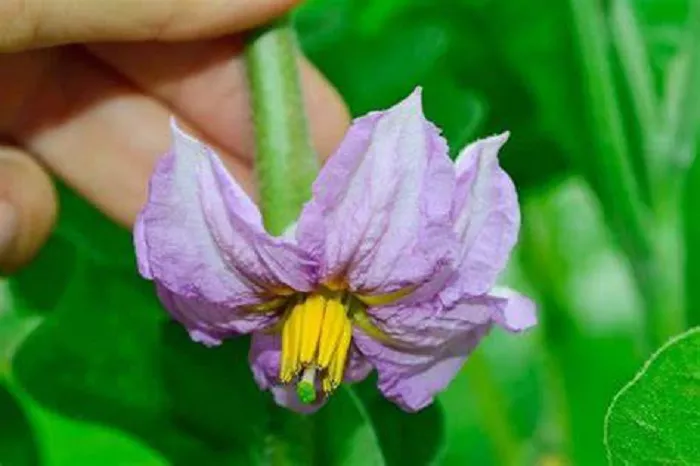Pollinating eggplant flowers is a crucial step in ensuring a bountiful harvest. Whether you are a seasoned gardener or a novice with a green thumb, understanding the process can significantly enhance your gardening experience. This article will guide you through the intricacies of eggplant pollination, offering practical tips and insights to help you nurture healthy and productive plants.
Understanding Eggplant Pollination
Eggplants, like many other plants, rely on pollination to produce fruit. Pollination is the transfer of pollen from the male part of the flower (the anther) to the female part (the stigma). In nature, this process is often facilitated by insects such as bees. However, in controlled environments like greenhouses or when insect activity is low, manual pollination becomes essential.
The Role of Pollinators
Insects play a vital role in the pollination process. Bees, in particular, are efficient pollinators. They visit flowers to collect nectar and pollen, inadvertently transferring pollen from one flower to another. This natural process is essential for the fertilization of the eggplant flowers. However, factors such as weather conditions, pesticide use, and habitat loss can reduce the number of pollinators in your garden.
When to Pollinate
Timing is crucial when it comes to pollinating eggplant flowers. Eggplants typically bloom in the summer months, with flowers opening in the early morning and remaining viable for a few days. The best time to pollinate is in the morning when the flowers are fully open and the pollen is most viable.
Manual Pollination Techniques
Manual pollination is a straightforward process that can be done with simple tools. Here are some effective techniques to help you pollinate your eggplant flowers successfully.
Using a Soft Brush
A small, soft-bristled brush is an excellent tool for manual pollination. Gently brush the inside of each flower, moving from one flower to another. This mimics the action of a bee, transferring pollen from the anthers to the stigma. Be sure to handle the flowers carefully to avoid damaging them.
Vibrating the Flowers
Another effective method is to gently vibrate the flowers. This can be done by tapping the stem or using a small electric toothbrush. The vibration helps release the pollen from the anthers, allowing it to settle on the stigma. This method is particularly useful for self-pollinating varieties of eggplants.
Hand Pollination with a Cotton Swab
A cotton swab can also be used for hand pollination. Dip the swab into the pollen from one flower and then transfer it to the stigma of another. This method is precise and ensures that pollen is effectively transferred. It is especially useful for small-scale gardening or when dealing with specific varieties that require cross-pollination.
Tips for Successful Pollination
To ensure successful pollination, it is important to follow a few key tips. These practices will help you maximize the chances of your eggplant flowers producing fruit.
Maintain Proper Plant Health
Healthy plants are more likely to produce viable flowers and attract pollinators. Ensure your eggplants receive adequate sunlight, water, and nutrients. Regularly check for signs of disease or pest infestation and address any issues promptly.
Increase Pollinator Activity
Encourage pollinators to visit your garden by planting a variety of flowering plants that attract bees and other beneficial insects. Providing a diverse habitat can help support a healthy population of pollinators, which in turn benefits your eggplants.
Monitor Flower Development
Keep a close eye on the development of your eggplant flowers. Look for signs of successful pollination, such as the withering of the petals and the swelling of the ovary. If you notice that flowers are not setting fruit, consider implementing manual pollination techniques.
Common Challenges and Solutions
Despite your best efforts, you may encounter challenges during the pollination process. Understanding these issues and knowing how to address them can help you overcome obstacles and achieve a successful harvest.
Insufficient Pollen Transfer
If you notice that flowers are not setting fruit, it may be due to insufficient pollen transfer. Ensure that you are using the correct technique for manual pollination and that the pollen is being effectively transferred. You may also need to increase the frequency of your pollination efforts.
Environmental Factors
Environmental conditions such as extreme heat, humidity, or drought can affect the viability of pollen and the overall health of your plants. Provide shade during extreme heat, ensure proper drainage to avoid waterlogging, and maintain consistent watering to help your plants thrive.
Pest and Disease Management
Pests and diseases can impact the health of your eggplants and reduce their ability to produce viable flowers. Regularly inspect your plants for signs of infestation or disease and take appropriate measures to control these issues. Organic pest control methods can help protect your plants without harming beneficial pollinators.
Conclusion
Pollinating eggplant flowers is a rewarding process that can significantly enhance your gardening experience. By understanding the basics of pollination and implementing effective techniques, you can ensure a bountiful harvest. Whether you rely on natural pollinators or take a hands-on approach with manual pollination, the key is to provide your plants with the care and attention they need to thrive. With patience and dedication, you can enjoy a fruitful and fulfilling gardening journey.

